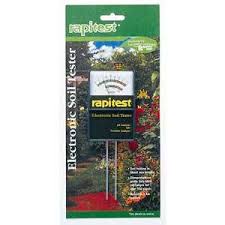
Includes:
Electronic Soil Tester, complete instructions for testing pH and nutrient levels, tips to adjust pH and soil nutrition and a chart with the pH preferences for over 350 plants.
Requires 1 AA battery (not included).
The dual-purpose Rapitest Electronic Soil Tester is designed for simplicity of use with accurate results. It tests both soil pH (acidity) and soil fertility.
Why Should You Test pH?
Plants need the correct pH (acidity/alkalinity) level which controls how well plants utilize the nutrients available in your soil. All plants have a pH preference, so it is important to know the pH level of your soil. You can then choose plants with the same pH preferences, avoid those that will not do well in your soil, or know how to go about supplying their special growing needs. By testing your soil, you determine its condition so that you can adjust pH more accurately, effectively and economically.
Why Should You Test Your Soil?
Plants need food (nutrients) for healthy growth. Nitrogen, Phosphorus and Potash (N, P and K for short) play a vital role in plant growth just as vitamins, minerals, carbohydrates and protein do in our health. Knowing the levels of these nutrients in your soil is crucial to better maintaining your plants.
When Should You Test Your Soil?
Soil should be tested periodically throughout the growing season, but it is especially recommended to test before planting in Spring and when preparing beds in Fall. And, if you feel your plants are not growing well, a soil test may help.
How Does Rapitest Electronic Soil Tester Work?
Slide selector switch from "Off" position to either "pH Analysis" or "Fertilizer Analysis" position. Collect a soil sample from the area to be tested and thoroughly moisten. Insert probe completely into the soil sample. Within seconds the meter will indicate the pH or fertility condition level of your soil. Check the detailed pH preference list in the enclosed booklet, then select the plants suitable for your soil or follow the instructions for correcting your soil condition.

